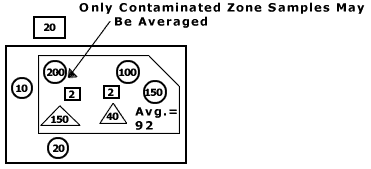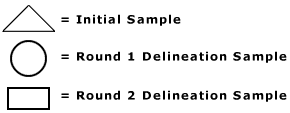|
 Site Remediation News Site Remediation News  Spring 1995 (Vol 7 N0 2) Spring 1995 (Vol 7 N0 2)  Article 08 Article 08
Compliance
Averaging By: Brian J. Sogorka,
Bureau of Environmental Evaluation & Risk Assessment
The average contaminant concentration
in an area of concern may be used to determine compliance with remediation
standards or the Soil
Cleanup Criteria rather than the contaminant concentration
of individual samples. This approach is called "compliance averaging."
An article describing the department's policies on compliance averaging
appeared in the November 1993 Site Remediation News. The department's
policy on the use of the multiplication factors has been modified (see
item 4d
below) and new policies have been added (see items
5, 6 and
7 below). The department's current requirements
for using compliance averaging are described below.
To minimize the impact of the new
policy described in 4d below on sites currently undergoing remediation,
this policy will not be effective until July 1, 1995, except as follows.
Remedial action workplans approved before the effective date need not
comply with the new guidance, subject to case by case review by the department.
However, remediation, including sampling or cleanup activities, conducted
prior to the effective date of the guidance without remedial action workplan
approval will be evaluated by the department for substantial compliance
with the new guidance. Any questions regarding implementation of the department's
guidance should be directed to your Case Manager.
Compliance averaging can only be used after a remedial investigation
has been completed which fully delineates the nature and extent of the
contamination present. See N.J.A.C.
7:26E, the Technical Requirements for Site Remediation
(Technical Rules), Subchapter 4 for the requirements of a remedial investigation.
It is not appropriate to use compliance averaging based upon the information
obtained in a site investigation. The objective of a site investigation
is to determine if contamination is present above any applicable remediation
standards or Soil Cleanup Criteria. Sample locations used during the
site investigation must be biased to the suspected location of greatest
contamination and therefore, results cannot be averaged. If such biased
samples are contaminated above any applicable remediation standards
or Soil Cleanup Criteria, then contaminant delineation in a remedial
investigation is required. The Technical Rules, at N.J.A.C. 7:26E-4.9(c)3i, specify certain requirements
for averaging data:
The arithmetic mean must be used to calculate the average contaminant
concentration;
One-half of the method detection limit for non-detectable results
from samples which have not been diluted must be used to calculate
the average contaminant concentration. Any estimated values (also
known as "J" values) must be used "as reported" to calculate the
average contaminant concentration; Non-detectable results for samples which have been diluted may
not be used to calculate the average contaminant concentration;
The requirement at 4.9(c)3i(5) excludes from compliance averaging
any samples from a "clean" buffer zone identified around a contaminated
area. A suspected area of concern is often reduced or expanded based
on remedial investigation delineation sampling and only samples
which lie within the modified area of concern (excluding clean zones)
can be utilized for compliance averaging (see Figure
1); The requirement at 4.9(c)3i(5) also specifies that samples from
different depth intervals may not be averaged together to determine
compliance. However, under certain circumstances it may be appropriate
to average data for two or more vertical sample increments. For
example, if only the "Impact to Ground Water" Soil Cleanup Criteria
are driving the cleanup, it may be appropriate, based on site specific
conditions, to average data for two or more vertical sample increments.
If a "direct contact" Soil Cleanup Criterion is driving the cleanup
but the soil is unlikely to be disturbed (for example, beneath a
building or greater than ten feet deep), it may also be appropriate
to average data for two or more vertical sample increments. Such
requests require a variance decision pursuant to N.J.A.C. 7:26E-1.6(d).
Samples exceeding the 10,000 ppm total organic limit or the
1,000 ppm total volatile organic limit cannot be averaged for compliance
because these samples represent "gross" contaminant levels and, therefore,
no samples may exceed these limits. There is a limit on the maximum allowable concentration for individual
samples when compliance averaging through the application of a multiplication
factor which is applied to the Soil Cleanup Criterion or health based
criterion, whichever is lower (see item 4d
below for more details). The multiplication factors vary
depending on the specific Soil Cleanup Criterion. No single sample can
exceed the applicable Soil Cleanup Criteria for a specific contaminant
as follows:
If the Soil Cleanup Criterion is 10 ppm or less, then individual
soil samples cannot exceed the Soil Cleanup Criterion by more than
a factor of 10 or 50 ppm (ceiling level), whichever is less; If the applicable Soil Cleanup Criterion is greater than 10 ppm
but less than or equal to 100 ppm, then individual soil samples
cannot exceed the Soil Cleanup Criterion by more than a factor of
5 or 200 ppm (ceiling level), whichever is less; If the applicable Soil Cleanup Criterion is greater than 100
ppm, then individual soil samples cannot exceed the Soil Cleanup
Criterion by more than a factor of 2. The department's guidance, as described in the
November 1993 Site Remediation News, was to apply the multiplication
factors to the Soil Cleanup Criteria. However, the department's
current guidance is to apply the factors to health based criteria,
not Soil Cleanup Criteria which are based on natural background
or practical quantitation levels (PQLs). The department believes
that applying the multiplication factors to health based criteria
is more consistent with the intent of the factors, that is, to limit
exposure to high concentrations of the contaminant. This change
in guidance has the following implications:
1) Elimination of the option to average for arsenic and thallium:
The 20 ppm Soil Cleanup Criterion for arsenic is based on natural
background which is already 50 times higher than the health based
number for arsenic (0.4 ppm). Therefore, allowing individual samples
to exceed the Soil Cleanup Criterion would not be appropriate unless
a site specific remediation standard was developed.
Exceedances of the 20 ppm arsenic criterion due to natural background
conditions would not require cleanup but would require a site specific
remediation standard to document that local natural background was
greater than 20 ppm.
The 2 ppm Soil Cleanup Criterion for thallium is based on a PQL
but the health based number is zero. Therefore, averaging is not
appropriate. Exceedances of the 2 ppm thallium criterion would require
a site specific remediation standard.
2) More stringent compliance criteria for benzo(a)pyrene and
dibenz(a,h)anthracene:
The 0.66 ppm Soil Cleanup Criteria for these compounds are based
on a PQL which is approximately 7 times higher than the health based
number (0.09 ppm). Applying the 10x factor to 0.09 ppm means that,
when averaging is applied, no sample may exceed 0.9 ppm.
3) More stringent compliance criteria for beryllium:
The 1 ppm Soil Cleanup Criterion for beryllium is based on a PQL
which is 5 times higher than the health based number (0.2 ppm).
Applying the 10x factor to 0.2 ppm means that, when averaging is
applied, no sample may exceed 2 ppm.
4) Other contaminants affected by this policy are bis(2-chloroethyl)ether,
hexachlorobenzene, and N-nitrosodi-n-propylamine. As these contaminants
are not commonly encountered in site remediation, the department
should be contacted on a case specific basis to address any compliance
averaging issues. The Soil Cleanup Criteria for PCBs are based on the
total PCB concentration of the sample. As there is no standard laboratory
protocol for reporting and averaging total PCBs, the department uses
the following approach:
To calculate total PCBs for an individual sample, add together any "hits"
for the individual Arochlors. If there are no "hits", report the highest
method detection limit as the total PCB method detection limit. When
averaging total PCB data for two or more samples, first calculate total
PCBs for each sample as above, then apply the applicable averaging requirements
described in this article. The department has found that strict adherence to
the Soil Cleanup Criteria is sometimes overly conservative for small
areas of moderately contaminated soil. In general, the smaller the area
of contamination, the less likely it is that there will be significant
exposure to the contaminants. In addition, if the contamination is at
depth in the soil column (two feet below ground surface or deeper),
the potential for exposure is even further reduced. It is usually not
possible to use compliance averaging for such isolated areas of contamination
because it is not permissible to average clean zone samples with the
contaminated area samples.
Therefore, the following approach may be used if, after completion of
a remedial investigation, contaminated soils at an area of concern are
not in compliance with a Soil Cleanup Criterion after averaging, but
the data indicate that there is only a de minimis amount of contaminated
soil. The department will consider "no further action" proposals without
environmental restrictions if all the following criteria are met:
Contaminant levels are "moderate"; that is, below the multiplication
factor limits or ceiling levels, and below the 10,000 ppm total
organic limit and the 1,000 ppm total volatile organic limit; Since the multiplication factor limits are applied to health-based
numbers, the restrictions applicable to averaging also apply to
de minimis exemptions. Therefore, the de minimis exemption cannot
be applied to arsenic or thallium contamination; Sample data document that there is only a de minimis amount of
contaminated soil remaining in the area of concern. In general,
a de minimis area of contaminated soil is considered to be a six
inch layer of soil over a ten foot radius. In addition, only contaminated
soil at two or more feet below ground surface will be considered
for this exemption. Considering the depth and the limited areal
extent of the contaminants, direct soil exposure is expected to
be relatively infrequent.
It may sometimes be acceptable to apply the de minimis exemption
to larger areas as well, but this should be reviewed on a site specific
basis. Exception decisions should consider such factors as contaminant
concentration, the volume of contaminated soil, and the size of
the area where exposure to the contaminants may occur. For example,
assume that the Soil Cleanup Criterion is 5 ppm, the isolated "hit"
is 6 ppm, and the "clean zone" is 20 feet away. In this situation,
although the de minimis criteria above have not been met, the de
minimis exemption might still be appropriate because the contamination
is present at a concentration only slightly above the Soil Cleanup
Criterion. An evaluation of the contaminant mass, persistence and location
indicates limited potential for significant human health or environmental
impacts, including ground water impacts; and There can be only one de minimis exemption per area of concern. Sample results for contaminated soil remaining in
an area of concern may be averaged after remedial actions when soils
have been excavated or otherwise permanently remediated if the following
conditions are met:
Data from clean fill used to replace contaminated soils in the
area of concern cannot be included to calculate the average; Sidewall sample data from excavated areas may be used in the
average if sample data from the same six inch depth increment are
averaged; and Post remediation bottom sample data may be averaged with other
sample data from the same six-inch depth increment.
Figure
1
|
Compliance
Averaging
N.J.A.C. 7:26E-4.9(c)3i Soil
Criteria = 100 ppm   
 
|
|
 |


